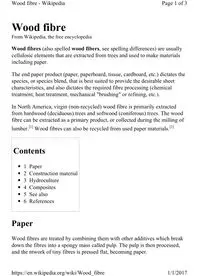
Wood Fibre-2017 PDF
Preview Wood Fibre-2017
Wood fibre From Wikipedia, the free encyclopedia Wood fibres (also spelled wood fibers, see spelling differences) are usually cellulosic elements that are extracted from trees and used to make materials including paper. The end paper product (paper, paperboard, tissue, cardboard, etc.) dictates the species, or species blend, that is best suited to provide the desirable sheet characteristics, and also dictates the required fibre processing (chemical treatment, heat treatment, mechanical "brushing" or refining, etc.). In North America, virgin (non-recycled) wood fibre is primarily extracted from hardwood (deciduous) trees and softwood (coniferous) trees. The wood fibre can be extracted as a primary product, or collected during the milling of lumber.[1] Wood fibres can also be recycled from used paper materials.[2] Contents ◾ 1 Paper ◾ 2 Construction material ◾ 3 Hydroculture ◾ 4 Composites ◾ 5 See also ◾ 6 References Paper Wood fibres are treated by combining them with other additives which break down the fibres into a spongy mass called pulp. The pulp is then processed, and the ntwork of tiny fibres is pressed flat, becoming paper. Page 1 of 3 Wood fibre - Wikipedia 1/1/2017 https://en.wikipedia.org/wiki/Wood_fibre Construction material Wood fibres can be pressed into hard, flat panels which can be used as a less expensive alternative to wood or plywood in situations not requiring structural strength.[3] Hydroculture Wood fibres can be used as a substrate in hydroponics. Wood wool (i.e. wood slivers) have been a substrate of choice since the earliest days of the hydroponics research.[4] However, more recent research suggests that wood fibre can have detrimental affects on "plant growth regulators".[5] Composites Wood fibres can be combined with thermoplastics to create strong, waterproof products for outdoor use, such as deck boards or outdoor furniture.[6] See also ◾ Hemp paper ◾ Pulp (paper) ◾ Woodfibre, British Columbia ◾ Wood flour, a form of wood fibre References 1. Philip Joseph Burton (2003). Towards Sustainable Management of the Boreal Forest. NRC Research Press. pp. 759–. ISBN 978-0-660-18762-4. 2. Pratima Bajpai (21 November 2013). Recycling and Deinking of Recovered Paper. Elsevier Science. pp. 8–. ISBN 978-0-12-417169-5. Page 2 of 3 Wood fibre - Wikipedia 1/1/2017 https://en.wikipedia.org/wiki/Wood_fibre 3. Sustainable Building - Design Manual: sustainable building design practices. The Energy and Resources Institute (TERI). 1 January 2004. pp. 104–. ISBN 978- 81-7993-053-3. 4. Gericke, William F. (1940). The Complete Guide to Soilless Gardening (1st ed.). London: Putnam. pp. 38 & 84. ISBN 9781163140499. 5. Wallheimer, Brian (October 25, 2010). "Rice hulls a sustainable drainage option for greenhouse growers". Purdue University. Retrieved August 30, 2012. 6. Caroline Baillie (8 March 2005). Green Composites: Polymer Composites and the Environment. CRC Press. pp. 94–. ISBN 978-0-8493-2576-2. Retrieved from "https://en.wikipedia.org/w/index.php? title=Wood_fibre&oldid=745297698" Categories: Cellulose ◾ This page was last modified on 20 October 2016, at 09:57. ◾ Text is available under the Creative Commons Attribution-ShareAlike License; additional terms may apply. By using this site, you agree to the Terms of Use and Privacy Policy. Wikipedia® is a registered trademark of the Wikimedia Foundation, Inc., a non-profit organization. Page 3 of 3 Wood fibre - Wikipedia 1/1/2017 https://en.wikipedia.org/wiki/Wood_fibre
